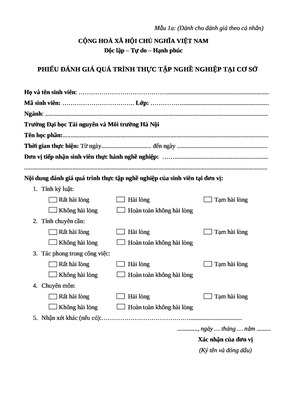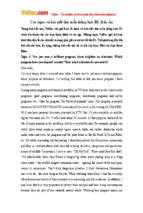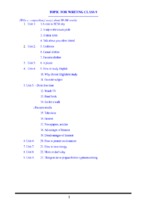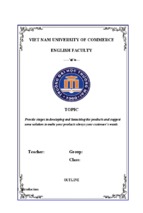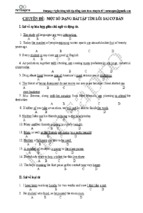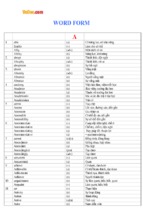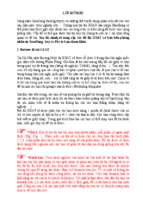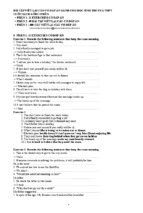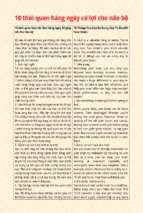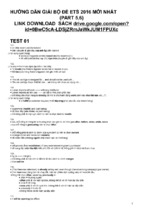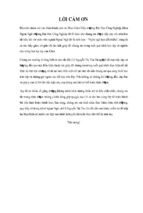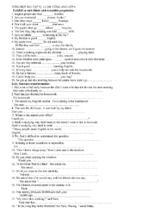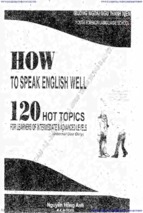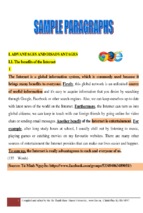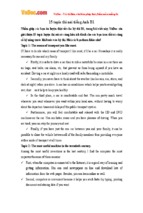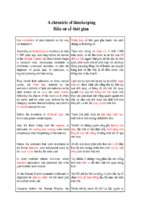C h a p t e r
1
Prewriting
GETTING STARTED (OR SOUP-CAN LABELS
CAN BE FASCINATING)
For many writers, getting started is the hardest part. You may have noticed
that when it is time to begin a writing assignment, you suddenly develop an
enormous desire to straighten your books, water your plants, or sharpen your
pencils for the fifth time. If this situation sounds familiar, you may find it reassuring to know that many professionals undergo these same strange compulsions before they begin writing. Jean Kerr, author of Please Don’t Eat the
Daisies, admits that she often finds herself in the kitchen reading soup-can labels—or anything—in order to prolong the moments before taking pen in
hand. John C. Calhoun, vice president under Andrew Jackson, insisted he had
to plow his fields before he could write, and Joseph Conrad, author of Lord Jim
and other novels, is said to have cried on occasion from the sheer dread of sitting down to compose his stories.
To spare you as much hand-wringing as possible, this chapter presents
some practical suggestions on how to begin writing your short essay. Although all writers must find the methods that work best for them, you may
find some of the following ideas helpful.
But no matter how you actually begin putting words on paper, it is absolutely essential to maintain two basic ideas concerning your writing task.
Before you write a single sentence, you should always remind yourself that
1. You have some valuable ideas to tell your reader, and
2. More than anything, you want to communicate those ideas to your
reader.
These reminders may seem obvious to you, but without a solid commitment to your own opinions as well as to your reader, your prose will be lifeless
and boring. If you don’t care about your subject, you can’t very well expect
anyone else to. Have confidence that your ideas are worthwhile and that your
reader genuinely wants, or needs, to know what you think.
Equally important, you must also have a strong desire to tell others what
you are thinking. One of the most common mistakes inexperienced writers
4
PART ONE - THE BASICS OF THE SHORT ESSAY
make is failing to move past early stages in the writing process in which they
are writing for—or writing to—themselves only. In the first stages of composing
an essay, writers frequently “talk” on paper to themselves, exploring thoughts,
discovering new insights, making connections, selecting examples, and so on.
The ultimate goal of a finished essay, however, is to communicate your opinions
to others clearly and persuasively. Whether you wish to inform your readers,
change their minds, or stir them to action, you cannot accomplish your purpose by writing so that only you understand what you mean. The burden of
communicating your thoughts falls on you, not the reader, who is under no
obligation to struggle through confused, unclear prose, paragraphs that begin
and end for no apparent reason, or sentences that come one after another with
no more logic than lemmings following one another to the sea.
Therefore, as you move through the drafting and revising stages of your
writing process, commit yourself to becoming increasingly aware of your
reader’s reactions to your prose. Ask yourself as you revise your drafts, “Am I
moving beyond writing just to myself? Am I making myself clear to others who
may not know what I mean?” Much of your success as a writer depends on an
unflagging determination to communicate clearly with your readers.
SELECTING A SUBJECT
Once you have decided that communicating clearly with others is your ultimate goal, you are ready to select the subject of your essay. Here are some
suggestions on how to begin:
Start early. Writing teachers since the earth’s crust cooled have been
pushing this advice, and for good reason. It’s not because teachers are egoists
competing for the dubious honor of having the most time-consuming course; it
is because few writers, even experienced ones, can do a good job when
rushed. You need time to mull over ideas, organize your thoughts, revise and
polish your prose. Rule of thumb: always give yourself twice as much time as
you think you’ll need to avoid the 2:00 -A.M.-why-did-I-come-to-college panic.
Find your best space. Develop some successful writing habits by thinking
about your very own writing process. When and where do you usually do your
best composing? Some people write best early in the morning; others think
better later in the day. What time of day seems to produce your best efforts?
Where are you working? At a desk? In your room or in a library? Do you start
drafting ideas on a computer or do you begin with paper or a yellow pad? With
a certain pen or sharpened pencil? Most writers avoid noise and interruptions
( TV, telephone, friends, etc.), although some swear by music in the background. If you can identify a previously successful writing experience, try duplicating its location, time, and tools to help you calmly address your new
writing task. Or consider trying new combinations of time and place if your
previous choices weren’t as productive as you would have liked. Recognition
and repeated use of your most comfortable writing “spot” may shorten your
hesitation to begin composing; your subconscious may recognize the pattern
CHAPTER 1 - PREWRITING
(“Hey, it’s time to write!”) and help you start in a positive frame of mind. (Remember that it’s not just writers who repeat such rituals—think of the athletes you’ve heard about who won’t begin a game without wearing their lucky
socks. If it works for them, it can work for you!)
Select something in which you currently have a strong interest. If the
essay subject is left to you, think of something fun, fascinating, or frightening
you’ve done or seen lately, perhaps something you’ve already told a friend
about. The subject might be the pleasure of a new hobby, the challenge of a recent book or movie, or even the harassment of registration—anything in
which you are personally involved. If you aren’t enthusiastic enough about
your subject to want to spread the word, pick something else. Bored writers
write boring essays.
Don’t feel you have nothing from which to choose your subject. Your days
are full of activities, people, joys, and irritations. Essays do not have to be
written on lofty intellectual or poetic subjects—in fact, some of the world’s
best essays have been written on such subjects as china teacups, roast pig,
and chimney sweeps. Think: what have you been talking or thinking about
lately? What have you been doing that you’re excited about? Or what about
your past? Reflect a few moments on some of your most vivid memories—special people, vacations, holidays, childhood hideaways, your first job or first
date—all are possibilities.
Still searching? Make a list of all the subjects on which you are an expert.
None, you say? Think again. Most of us have an array of talents we hardly acknowledge. Perhaps you play the guitar or make a mean pot of chili or know
how to repair a sports car. You’ve trained a dog or become a first-class housesitter or gardener. You know more about computers or old baseball cards than
any of your friends. You play soccer or volleyball or Ping-Pong. In other words,
take a fresh, close look at your life. You know things that others don’t . . . now
is your chance to enlighten them!
If a search of your immediate or past personal experience doesn’t turn up
anything inspiring, you might try looking in the campus newspaper for stories
that arouse your strong feelings; don’t skip the “Letters to the Editor” column.
What are the current topics of controversy on your campus? How do you feel
about open admissions? A particular graduation requirement? Speakers or
special-interest groups on campus? Financial aid applications? Registration
procedures? Parking restrictions? Consider the material you are studying in
your other classes: reading The Jungle in a literature class may spark an investigative essay on the hot dog industry today, or studying previous immigration
laws in your history class may lead you to an argument for or against current
immigration practices. Similarly, your local newspaper or national magazines
might suggest essay topics to you on local, national, or international affairs
that affect your life. Browsing the Internet can provide you with literally thousands of diverse opinions and controversies that invite your response.
In other words, when you’re stuck for an essay topic, take a closer look at
your environment: your own life—past, present, and future; your hometown;
your college town; your state; your country; and your world. You’ll probably
5
6
PART ONE - THE BASICS OF THE SHORT ESSAY
discover more than enough subjects to satisfy the assignments in your writing class.
Narrow a large subject. Once you’ve selected a general subject to write
on, you may find that it is too broad for effective treatment in a short essay;
therefore, you may need to narrow it somewhat. Suppose, for instance, you like
to work with plants and have decided to make them the subject of your essay.
The subject of “plants,” however, is far too large and unwieldy for a short
essay, perhaps even for a short book. Consequently, you must make your subject less general. “Houseplants” is more specific, but, again, there’s too much
to say. “Minimum-care houseplants” is better, but you still need to pare this
large, complex subject further so that you may treat it in depth in your short
essay. After all, there are many houseplants that require little attention. After
several more tries, you might arrive at more specific, manageable topics, such
as “houseplants that thrive in dark areas” or “the easy-care Devil’s Ivy.”
Then again, let’s assume you are interested in sports. A 500 -to-800 -word
essay on “sports” would obviously be superficial because the subject covers so
much ground. Instead, you might divide the subject into categories such as
“sports heroes,” “my years on the high school tennis team,” “women in gymnastics,” “my love of running,” and so forth. Perhaps several of your categories would
make good short essays, but after looking at your list, you might decide that your
real interest at this time is running and that it will be the topic of your essay.
FINDING YOUR ESSAY’S PURPOSE AND FOCUS
Even after you’ve narrowed your large subject to a more manageable topic,
you still must find a specific purpose for your essay. Why are you writing
about this topic? Do your readers need to be informed, persuaded, entertained? What do you want your writing to accomplish?
In addition to knowing your purpose, you must also find a clear focus or direction for your essay. You cannot, for example, inform your readers about
every aspect of running. Instead, you must decide on a particular part of the
sport and then determine the main point you want to make. If it helps, think of a
camera: you see a sweeping landscape you’d like to photograph but you know
you can’t get it all into one picture, so you pick out a particularly interesting
part of the scene. Focus in an essay works in the same way; you zoom in, so to
speak, on a particular part of your topic and make that the focus of your paper.
Sometimes part of your problem may be solved by your assignment; your
teacher may choose the focus of your essay for you by asking for certain specific information or by prescribing the method of development you should use
(compare running to aerobics, explain the process of running properly, analyze
the effects of daily running, and so forth). But if the purpose and focus of your
essay are decisions you must make, you should always allow your interest and
knowledge to guide you. Often a direction or focus for your essay will surface as
you narrow your subject, but don’t become frustrated if you have to discard
several ideas before you hit the one that’s right. For instance, you might first
consider writing on how to select running shoes and then realize that you know
CHAPTER 1 - PREWRITING
too little about the shoe market, or you might find that there’s just too little of
importance to say about running paths to make an interesting 500 -word essay.
Let’s suppose for a moment that you have thought of a subject that interests you—but now you’re stuck. Deciding on something to write about this
subject suddenly looks as easy as nailing Jell-O to your kitchen wall. What
should you say? What would be the purpose of your essay? What would be interesting for you to write about and for readers to hear about?
At this point, you may profit from trying more than one prewriting exercise,
designed to help you generate some ideas about your topic. The exercises described next are, in a sense, “pump primers” that will get your creative juices
flowing again. Because all writers compose differently, not all of these exercises will work for you—in fact, some of them may lead you nowhere. Nevertheless, try all of them at least once or twice; you may be surprised to
discover that some pump-primer techniques work better with some subjects
than with others.
PUMP-PRIMER TECHNIQUES
1. Listing
Try jotting down all the ideas that pop into your head about your topic.
Free-associate; don’t hold back anything. Try to brainstorm for at least ten
minutes.
A quick list on running might look like this:
fun
healthy
relieves tension
no expensive equipment
shoes
poor shoes won’t last
shin splints
fresh air
good for heart
jogging paths vs. streets
hard surfaces
muscle cramps
going too far
going too fast
sense of accomplishment
training for races
both sexes
any age group
running with friend or spouse
too much competition
great expectations
good for lungs
improves circulation
firming
no weight loss
warm-ups before run
cool-downs after
getting discouraged
hitting the wall
marathons
As you read over the list, look for connections between ideas or one large idea
that encompasses several small ones. In this list, you might first notice that
many of the ideas focus on improving health (heart, lungs, circulation), but
you discard that subject because a “running improves health” essay is too obvious; it’s a topic that’s been done too many times to say anything new. A
closer look at your list, however, turns up a number of ideas that concern how
7
8
PART ONE - THE BASICS OF THE SHORT ESSAY
not to jog or reasons why someone might become discouraged and quit a
running program. You begin to think of friends who might have stuck with
running as you have if only they’d warmed up properly beforehand, chosen
the right places to run, paced themselves more realistically, and so on. You
decide, therefore, to write an essay telling first-time runners how to start a
successful program, how to avoid a number of problems, from shoes to track
surfaces, that might otherwise defeat their efforts before they’ve given the
sport a chance.
2. Freewriting
Some people simply need to start writing to find a focus. Take out several
sheets of blank paper, give yourself at least ten to fifteen minutes, and begin
writing whatever comes to mind on your subject. Don’t worry about spelling,
punctuation, or even complete sentences. Don’t change, correct, or delete anything. If you run out of things to say, write “I can’t think of anything to say” until
you can find a new thought. At the end of the time period you may discover that
by continuously writing you will have written yourself into an interesting topic.
Here are examples of freewriting from students who were given ten minutes to write on the general topic of “nature.”
STUDENT 1:
I’m really not the outdoorsy type. I’d rather be inside somewhere than out in Nature tromping through the bushes. I
don’t like bugs and snakes and stuff like that. Lots of my
friends like to go hiking around or camping but I don’t.
Secretly, I think maybe one of the big reasons I really don’t
like being out in Nature is because I’m deathly afraid of
bees. When I was a kid I was out in the woods and ran into a
swarm of bees and got stung about a million times, well, it
felt like a million times. I had to go to the hospital for a few
days. Now every time I’m outside somewhere and something, anything, flies by me I’m terrified. Totally paranoid.
Everyone kids me because I immediately cover my head. I
keep hearing about killer bees heading this way, my worst
nightmare come true. . . .
STUDENT 2:
We’re not going to have any Nature left if people don’t do
something about the environment. Despite all the media
attention to recycling, we’re still trashing the planet left and
right. People talk big about “saving the environment” but
then do such stupid things all the time. Like smokers who
flip their cigarette butts out their car windows. Do they
think those filters are just going to disappear overnight?
CHAPTER 1 - PREWRITING
The parking lot by this building is full of butts this morning
where someone dumped their car ashtray. This campus is
full of pop cans, I can see at least three empties under desks
in this classroom right now. . . .
These two students reacted quite differently to the same general subject.
The first student responded personally, thinking about her own relationship to
“nature” (defined as being out in the woods), whereas the second student obviously associated nature with environmental concerns. More freewriting might
lead student 1 to a humorous essay on her bee phobia or even to an inquiry
about those dreaded killer bees; student 2 might write an interesting paper suggesting ways college students could clean up their campus or easily recycle
their aluminum cans.
Often freewriting will not be as coherent as these two samples; sometimes
freewriting goes nowhere or in circles. But it’s a technique worth trying. By allowing our minds to roam freely over a subject, without worrying about “correctness”
or organization, we may remember or discover topics we want to write about or
investigate, topics we feel strongly about and wish to introduce to others.
3. Looping*
Looping is a variation on freewriting that works amazingly well for many
people, including those who are frustrated rather than helped by freewriting.
Let’s assume you’ve been assigned that old standby “My Summer Vacation.” Obviously you must find a focus, something specific and important to
say. Again, take out several sheets of blank paper and begin to freewrite, as
described previously. Write for at least ten minutes. At the end of this period
read over what you’ve written and try to identify a central idea that has
emerged. This idea may be an important thought that occurred to you in the
middle or at the end of your writing, or perhaps it was the idea you liked
best for whatever reason. It may be the idea that was pulling you onward
when time ran out. In other words, look for the thought that stands out, that
seems to indicate the direction of your thinking. Put this thought or idea into
one sentence called the “center-of-gravity sentence.” You have now completed loop 1.
To begin loop 2, use your center-of-gravity sentence as a jumping-off point
for another ten minutes of freewriting. Stop, read what you’ve written, and
complete loop 2 by composing another center-of-gravity sentence. Use this
second sentence to start loop 3. You should write at least three loops and
three center-of-gravity sentences. At the end of three loops, you may find that
you have focused on a specific topic that might lead to a good essay. If you’re
not satisfied with your topic at this point, by all means try two or three more
loops until your subject is sufficiently narrowed and focused.
* This technique is suggested by Peter Elbow in Writing Without Teachers ( New York: Oxford University Press, 1975).
9
10
PART ONE - THE BASICS OF THE SHORT ESSAY
Here’s an example of one student’s looping exercise:
SUMMER VACATION
Loop 1
Center-ofgravity
sentence
Loop 2
I think summer vacations are very important aspects
of living. They symbolize getting away from daily routines,
discovering places and people that are different. When I
think of vacations I think mostly of traveling somewhere too
far to go, say, for a weekend. It is a chance to get away and
relax and not think about most responsibilities. Just have a
good time and enjoy yourself. Vacations can also be a time
of gathering with family and friends.
Vacations are meant to be used for traveling.
Vacations are meant for traveling. Last summer my
family and I drove to Yellowstone National Park. I didn’t
want to go at first. I thought looking at geysers would
be dumb and boring. I was really obnoxious all the way up
there and made lots of smart remarks about getting eaten
by bears. Luckily, my parents ignored me and I’m glad they
did, because Yellowstone turned out to be wonderful. It’s
not just Old Faithful—there’s lots more to see and learn
about, like these colorful boiling pools and boiling patches
of mud. I got interested in the thermodynamics of the pools
and how new ones are surfacing all the time, and how algae
make the pools different colors.
Center-ofgravity
sentence
Once I got interested in Yellowstone’s amazing pools,
my vacation turned out great.
Loop 3
Once I got interested in the pools, I had a good time,
mainly because I felt I was seeing something really unusual.
I knew I’d never see anything like this again unless I went to
Iceland or New Zealand (highly unlikely!). I felt like I was
learning a lot, too. I liked the idea of learning a lot about the
inside of the earth without having to go to class and study
books. I really hated to leave—Mom and Dad kidded me on
the way back about how much I’d griped about going on the
trip in the first place. I felt pretty dumb. But I was really
glad I’d given the Park a closer look instead of holding on to
my view of it as a boring bunch of water fountains. I would
have had a terrible time, but now I hope to go back someday. I think the experience made me more open-minded
about trying new places.
Center-ofgravity
sentence
My vacation this summer was special because I was willing to put aside my expectations of boredom and learn some
new ideas about the strange environment at Yellowstone.
CHAPTER 1 - PREWRITING
At the end of three loops, this student has moved from the general subject
of “summer vacation” to the more focused idea that her willingness to learn
about a new place played an important part in the enjoyment of her vacation.
Although her last center-of-gravity sentence still contains some vague words
(“special,” “new ideas,” “strange environment”), the thought stated here may
eventually lead to an essay that will not only say something about this student’s vacation but may also persuade the readers to reconsider their attitude
toward taking trips to new places.
4. The Boomerang
Still another variation on freewriting is the technique called the boomerang,
named appropriately because, like the Australian stick, it invites your mind to
travel over a subject from opposite directions to produce new ideas.
Suppose, for example, members of your class have been asked to write
about their major field of study, which in your case is Liberal Arts. Begin by
writing a statement that comes into your mind about majoring in the Liberal
Arts and then freewrite on that statement for five minutes. Then write a second statement that approaches the subject from an opposing point of view,
and freewrite again for five minutes. Continue this pattern several times.
Boomeranging, like looping, can help writers see their subject in a new way
and consequently help them find an idea to write about.
Here’s an abbreviated sample of boomeranging:
1. Majoring in the Liberal Arts is impractical in today’s world.
[Freewrite for five minutes.]
2. Majoring in the Liberal Arts is practical in today’s world.
[Freewrite for five minutes.]
3. Liberal Arts is a particularly enjoyable major for me.
[Freewrite for five minutes.]
4. Liberal Arts is not always an enjoyable major for me.
[Freewrite for five minutes.]
And so on.
By continuing to “throw the boomerang” across your subject, you may not
only find your focus but also gain insight into other people’s views of your
topic, which can be especially valuable if your paper will address a controversial issue or one that you feel is often misunderstood.
5. Clustering
Another excellent technique is clustering (sometimes called “mapping”).
Place your general subject in a circle in the middle of a blank sheet of paper
and begin to draw other lines and circles that radiate from the original subject.
11
12
PART ONE - THE BASICS OF THE SHORT ESSAY
CHAPTER 1 - PREWRITING
Cluster those ideas that seem to fall together. At the end of ten minutes see if
a topic emerges from any of your groups of ideas.
Ten minutes of clustering on the subject of “A Memorable Holiday” might
look like the drawing on page 12.
This student may wish to brainstorm further on the Christmas he spent in
the hospital with a case of appendicitis or perhaps the Halloween he first experienced a house of horrors. By using clustering, he has recollected some important details about a number of holidays that may help him focus on an
occasion he wants to describe in his paper.
6. Cubing
Still another way to generate ideas is cubing. Imagine a six-sided cube that
looks something like the figure below.
Mentally, roll your subject around the cube and freewrite the answers to
the questions that follow. Write whatever comes to mind for ten or fifteen minutes; don’t concern yourself with the “correctness” of what you write.
a. Describe it: What does your subject look like? What size, colors, textures does it have? Any special features worth noting?
b. Compare or contrast it: What is your subject similar to? What is your
subject different from? In what ways?
c. Free-associate it: What does this subject remind you of? What does it
call to mind? What memories does it conjure up?
d. Analyze it: How does it work? How are the parts connected? What is its
significance?
e. Argue for or against it: What arguments can you make for or against
your subject? What advantages or disadvantages does it have? What
changes or improvements should be made?
f. Apply it: What are the uses of your subject? What can you do with it?
-
13
14
PART ONE - THE BASICS OF THE SHORT ESSAY
A student who had recently volunteered at a homeless shelter wrote the
following responses about her experience:
a. Describe it: I and five other members of my campus organization volunteered three Saturdays to work at the shelter here in town. We mainly
helped in the kitchen, preparing, serving, and cleaning up after meals.
At the dinners we served about 70 homeless people, mostly men but
also some families with small children and babies.
b. Compare or contrast it: I had never done anything like this before so it’s
hard to compare or contrast it to anything. It was different though
from what I expected. I hadn’t really thought much about the people
who would be there—or to be honest I think I thought they would be
pretty weird or sad and I was kind of dreading going there after I volunteered. But the people were just regular normal people. And they
were very, very polite to us.
c. Free-associate it: Some of the people there reminded me of some of my
relatives! John, the kitchen manager, said most of the people were just
temporarily “down on their luck” and that reminded me of my aunt and
uncle who came to stay with us for a while when I was in high school
after my uncle lost his job.
d. Analyze it: I feel like I got a lot out of my experience. I think I had some
wrong ideas about “the homeless” and working there made me think
more about them as real people, not just a faceless group.
e. Argue for or against it: I would encourage others to volunteer there.
The work isn’t hard and it isn’t scary. It makes you appreciate what
you’ve got and also makes you think about what you or your family
might do if things went wrong for a while. It also makes you feel good
to do something for people you don’t even know.
f. Apply it: I feel like I am more knowledgeable when I hear people talk
about the poor or the homeless in this town, especially those people
who criticize those who use the shelter.
After you’ve written your responses, see if any one or more of them give
you an idea for a paper. The student who wrote the preceding responses decided she wanted to write an article for her campus newspaper encouraging
people to volunteer at the shelter not only to provide much-needed help but
also to challenge their own preconceived notions about the homeless in her
college town. Cubing helped her realize she had something valuable to say
about her experience and gave her a purpose for writing.
7. Interviewing
Another way to find a direction for your paper is through interviewing.
Ask a classmate or friend to discuss your subject with you. Let your thoughts
CHAPTER 1 - PREWRITING
range over your subject as your friend asks you questions that arise naturally
in the conversation. Or your friend might try asking what are called “reporter’s questions” as she or he “interviews” you on your subject:
Who?
What?
Where?
When?
Why?
How?
Listen to what you have to say about your subject. What were you most interested in talking about? What did your friend want to know? Why? By talking
about your subject, you may find that you have talked your way into an interesting focus for your paper. If, after the interview, you are still stumped, question your friend: if he or she had to publish an essay based on the information
from your interview, what would that essay focus on? Why?
8. The Cross-Examination
If a classmate isn’t available for an interview, try interviewing, or crossexamining, yourself. Ask yourself questions about your general subject, just as
a lawyer might if you were on the witness stand. Consider using the five categories described below, which are adapted from those suggested by Aristotle,
centuries ago, to the orators of his day. Ask yourself as many questions in
each category as you can think of, and then go on to the next category. Jot
down brief notes to yourself as you answer.
Here are the five categories, plus six sample questions for each to illustrate the possibilities:
1. Definition
a. How does the dictionary or encyclopedia define or explain this
subject?
b. How do most people define or explain it?
c. How do I define or explain it?
d. What do its parts look like?
e. What is its history or origin?
f. What are some examples of it?
2. Comparison and Contrast
a.
b.
c.
d.
e.
f.
What is it similar to?
What does it differ from?
What does it parallel?
What is it opposite to?
What is it better than?
What is it worse than?
3. Relationship
a. What causes it?
b. What are the effects of it?
15
16
PART ONE - THE BASICS OF THE SHORT ESSAY
c.
d.
e.
f.
What larger group or category is it a part of?
What larger group or category is it in opposition to?
What are its values or goals?
What contradictions does it contain?
4. Circumstance
a.
b.
c.
d.
e.
f.
Is it possible?
Is it impossible?
When has it happened before?
What might prevent it from happening?
Why might it happen again?
Who has been or might be associated with it?
5. Testimony
a.
b.
c.
d.
e.
f.
What do people say about it?
What has been written about it?
What authorities exist on the subject?
Are there any relevant statistics?
What research has been done?
Have I had any direct experience with it?
Some of the questions suggested here, or ones you think of, may not be relevant to or useful for your subject. But some may lead you to ideas you wish to
explore in more depth, either in a discovery draft or by using another prewriting technique described in this chapter, such as looping or mapping.
9. Sketching
Sometimes when you have found or been assigned a general subject, the
words to explain or describe it just won’t come. Although listing or freewriting or one of the other methods suggested here work well for some people,
other writers find these techniques intimidating or unproductive. Some of
these writers are visual learners—that is, they respond better to pictorial representations of material than they do to written descriptions or explanations.
If, on occasion, you are stuck for words, try drawing or sketching or even cartooning the pictures in your mind.
You may be surprised at the details that you remember once you start
sketching. For example, you might have been asked to write about a favorite
place or a special person in your life or to compare or contrast two places you
have lived or visited. See how many details you can conjure up by drawing the
scenes or the people; then look at your details to see if some dominant impression or common theme has emerged. Your Aunt Sophie’s insistence on
wearing two pounds of costume jewelry might become the focus of a paragraph on her sparkling personality, or the many details you recalled about
your grandfather’s barn might lead you to a paper on the hardships of farm
life. For some writers, a picture can be worth a thousand words—especially if
that picture helps them begin putting those words on paper.
CHAPTER 1 - PREWRITING
10. Dramatizing the Subject
Some writers find it helpful to visualize their subject as if it were a drama
or play unfolding in their minds. Kenneth Burke, a thoughtful writer himself,
suggests that writers might think about human action in dramatists’ terms
and then see what sorts of new insights arise as the “drama” unfolds. Burke’s
dramatists’ terms might be adapted for our use and pictured this way:
Action
Actors
Motive
Setting
Method
Just as you did in the cubing exercise, try mentally rolling your subject
around the star above and explore the possibilities that emerge. For example,
suppose you want to write about your recent decision to return to college
after a long period of working, but you don’t know what you want to say about
your decision. Start thinking about this decision as a drama and jot down brief
answers to such questions as these:
Action:
Actors:
Motive:
Method:
What happened?
What were the results?
What is going to happen?
Who was involved in the action?
Who was affected by the action?
Who caused the action?
Who was for it and who was opposed?
What were the reasons behind the action?
What forces motivated the actors to perform as they did?
How did the action occur?
By what means did the actors accomplish the action?
17
18
PART ONE - THE BASICS OF THE SHORT ESSAY
Setting:
What was the time and place of the action?
What did the place look like?
What positive or negative feelings are associated with this
time or place?
These are only a few of the dozens of questions you might ask yourself about
your “drama.” ( If it helps, think of your “drama” as a murder mystery and answer the questions the police detective might ask: what happened here? to
whom? who did it? why? with what? when? where? and so on.)
You may find that you have a great deal to write about the combination of
actor and motive but very little to say in response to the questions on setting
or method. That’s fine—simply use the “dramatists’ approach” to help you
find a specific topic or idea you want to write about.
If at any point in this stage of the writing process you are experiencing Writer’s Block, you might turn to the suggestions for overcoming this common affliction, which appear on pages 116–118 in
Chapter 5. You might also find it helpful to read the section on
Keeping a Journal, pages 26–29 in this chapter, as writing in a relaxed mood on a regular basis may be the best long-term cure for
your writing anxiety.
AFTER YOU’VE FOUND YOUR FOCUS
Once you think you’ve found the focus of your essay, you may be ready to
compose a working thesis statement, an important part of your essay discussed in great detail in the next chapter. If you’ve used one of the prewriting
exercises outlined in this chapter, by all means hang onto it. The details and
observations you generated as you focused your topic may be useful to you as
you begin to organize and develop your body paragraphs.
✓
PRACTICING WHAT YOU’VE LEARNED
A. Some of the subjects listed below are too broad for a 500 -to-800 -word
essay. Identify those topics that might be treated in short papers and those
that still need to be narrowed.
1. The role of the modern university
2. My first (and last) experience with roller blading
3. The characters of William Shakespeare
4. Solar energy
CHAPTER 1 - PREWRITING
5. Collecting baseball cards
6. Gun-control laws
7. Down with throwaway bottles
8. Computers
9. The best teacher I’ve ever had
10. Selecting the right bicycle
B. Select two of the large subjects that follow and, through looping or listing
details or another prewriting technique, find focused topics that would be appropriate for essays of three to five pages.
1. music
2. cars
3. education
4. jobs
5. television commercials
6. politics
7. animals
8. childhood
9. pollution
10. athletics
DISCOVERING YOUR AUDIENCE
Once you have a focused topic and perhaps some ideas about developing your
essay, you need to stop a moment to consider your audience. Before you can
decide what information needs to go in your essay and what should be omitted, you must know who will be reading your paper and why. Knowing your
audience will also help you determine what voice you should use to achieve
the proper tone in your essay.
Suppose, for example, you are attending a college organized on the quarter system, and you decide to write an essay arguing for a switch to the
semester system. If your audience is composed of classmates, your essay will
probably focus on the advantages to the student body, such as better opportunities for in-depth study in one’s major, the ease of making better grades,
and the benefits of longer midwinter and summer vacations. However, if you
are addressing the Board of Regents, you might emphasize the power of the
semester system to attract more students, cut registration costs, and use professors more efficiently. If your audience is composed of townspeople who
know little about either system, you will have to devote more time to explaining the logistics of each one and then discuss the semester plan’s advantages
19
20
PART ONE - THE BASICS OF THE SHORT ESSAY
to the local merchants, realtors, restauranteurs, and so on. In other words, such
factors as the age, education, profession, and interests of your audience can make
a difference in determining which points of your argument to stress or omit, which
ideas need additional explanation, and what kind of language to adopt.
HOW TO IDENTIFY YOUR READERS
To help you analyze your audience before you begin writing your working thesis statement and rough drafts, here are some steps you may wish to follow:
1. First, see if your writing assignment specifies a particular audience (editors of a journal in your field or the Better Business Bureau of your town, for example) or a general audience of your peers (your classmates or readers of the
local newspaper, for instance). Even if your assignment does not mention an intended audience, try to imagine one anyway. Imagining specific readers will
help you stick to your goal of communicating with others. Forgetting that they
have an audience of real people often causes writers to address themselves to
their typing paper, a mistake that usually results in dull or unclear prose.
2. If a specific audience is designated, ask yourself some questions about
their motivation or reasons for reading your essay.
• What do these readers want to learn?
• What do they hope to gain?
• Do they need your information to make a decision? Formulate a new
plan? Design a new project?
• What action do you want them to take?
The answers to such questions will help you find both your essay’s purpose and its content. If, for example, you’re trying to persuade an employer to
hire you for a particular job, you certainly would write your application in a
way that stresses the skills and training the company is searching for. You may
have a fine hobby or wonderful family, but if your prospective employerreader doesn’t need to hear about that particular part of your life, toss it out
of this piece of writing.
3. Next, try to discover what knowledge your audience has of your subject.
• What, if anything, can you assume that your readers already know
about your topic?
• What background information might they need to know to understand
a current situation clearly?
• What facts, explanations, or examples will best present your ideas?
How detailed should you be?
• What terms need to be defined? Equipment explained?
Questions like these should guide you as you collect and discard information for your paper. An essay written to your colleagues in electrical engineering,
CHAPTER 1 - PREWRITING
for instance, need not explain commonly used technical instruments; to do
so might even insult your readers. But the same report read by your composition classmates would probably need more detailed explanation in order
for you to make yourself understood. Always put yourself in your readers’
place and then ask: what else do they need to know to understand this point
completely?
4. Once you have decided what information is necessary for your audience, dig a little deeper into your readers’ identities. Pose some questions
about their attitudes and emotional states.
•
•
•
•
Are your readers already biased for or against your ideas in some way?
Do they have positive or negative associations with your subject?
Are they fearful or anxious, reluctant or bored?
Do they have radically different expectations or interests?
It helps enormously to know the emotional attitudes of your readers toward
your subject. Let’s suppose you were arguing for the admission of a young child
with AIDS into a local school system, and your audience was the parent-teacher
organization. Some of your readers might be frightened or even hostile; knowing this, you would wisely begin your argument with a disarming array of information showing that no cases of AIDS have developed from the casual contact
of schoolchildren. In other words, the more you know about your audience’s attitudes before you begin writing, the more convincing your prose, because you
will make the best choices about both content and organization.
5. Last, think of any special qualities that might set your audience apart
from any other.
• Are they older or younger than your peers?
• Do they share similar educational experiences or training?
• Are they from a particular part of the world or country that might affect their perspective? Urban or rural?
• Are they in positions of authority?
Knowing special facts about your audience makes a difference, often in
your choice of words and tone. You wouldn’t, after all, use the same level of vocabulary addressing a group of fifth-graders as you would writing to the children’s teacher or principal. Similarly, your tone and word choice probably
wouldn’t be as formal in a letter to a friend as in a letter to the telephone company protesting your most recent bill.
Without question, analyzing your specific audience is an important step to
take before you begin to shape your rough drafts. And before you move on to
writing a working thesis, here are a few tips to keep in mind about all audiences,
no matter who your readers are or what their reasons for reading your writing.
1. Readers don’t like to be bored. Grab your readers’ attention and fight
to keep it. Remember the last dull movie you squirmed—or slept—through?
How much you resented wasting not only your money but your valuable time
21
22
PART ONE - THE BASICS OF THE SHORT ESSAY
as well? How you turned it off mentally and drifted away to someplace more
exciting? As you write and revise your drafts, keep imagining readers who are
as intelligent—and busy—as you are. Put yourself in their place: would you
find this piece of writing stimulating enough to keep reading?
2. Readers hate confusion and disorder. Can you recall a time when you
tried to find your way to a party, only to discover that a friend’s directions
were so muddled you wound up hours later, out of gas, cursing in a cornfield?
Or the afternoon you spent trying to follow a friend’s notes for setting up a
chemistry experiment, with explanations that twisted and turned as often as
a wandering stray cat? Try to relive such moments of intense frustration as
you struggle to make your writing clear and direct.
3. Readers want to think and learn (whether they realize it or not ).
Every time you write, you strike a bargain of sorts with your readers: in return for their time and attention, you promise to inform and interest them, to
tell them something new or show them something familiar in a different
light. You may enlighten them or amuse them or even try to frighten them—
but they must feel, in the end, that they’ve gotten a fair trade. As you plan,
write, and revise, ask yourself, “What are my readers learning?” If the honest
answer is “nothing important,” you may be writing only for yourself. ( If you
yourself are bored rereading your drafts, you’re probably not writing for
anybody at all.)
4. Readers want to see what you see, feel what you feel. Writing that is
vague keeps your readers from fully sharing the information or experience you
are trying to communicate. Clear, precise language—full of concrete details
and specific examples—lets your readers know that you understand your subject and that you want them to understand it, too. Even a potentially dull topic
such as tuning a car can become engaging to a reader if the right details are
provided in the right places: your terror as blue sparks leap under your nose
when the wrong wire is touched, the depressing sight of the screwdriver
squirming from your greasy fingers and disappearing into the oil pan, the sudden shooting pain when the wrench slips and turns your knuckles to raw hamburger. Get your readers involved and interested—and they’ll listen to what
you have to say. ( Details also persuade your reader that you’re an authority
on your subject; after all, no reader likes to waste time listening to someone
whose tentative, vague prose style announces “I only sort-of know what I’m
talking about here.”)
5. Readers are turned off by writers with pretentious, phony voices.
Too often inexperienced writers feel they must sound especially scholarly, scientific, or sophisticated for their essays to be convincing. In fact, the contrary
is true. When you assume a voice that is not yours, when you pretend to be
someone you’re not, you don’t sound believable at all—you sound phony. Your
readers want to hear what you have to say, and the best way to communicate
with them is in a natural voice. You may also believe that to write a good essay
it is necessary to use a host of unfamiliar, unpronounceable, polysyllabic
- Xem thêm -

